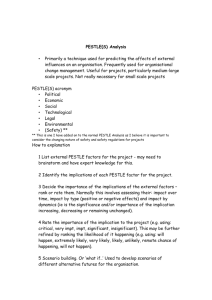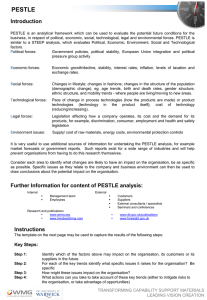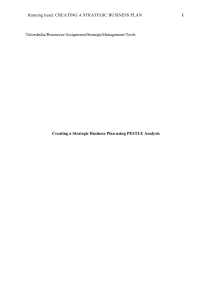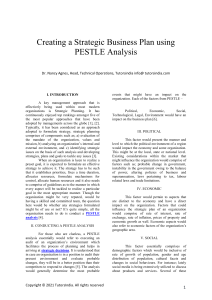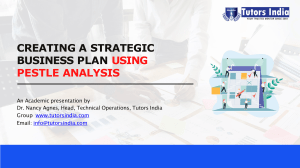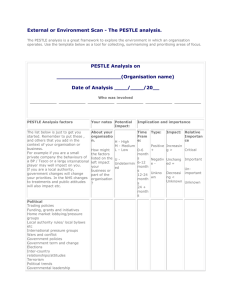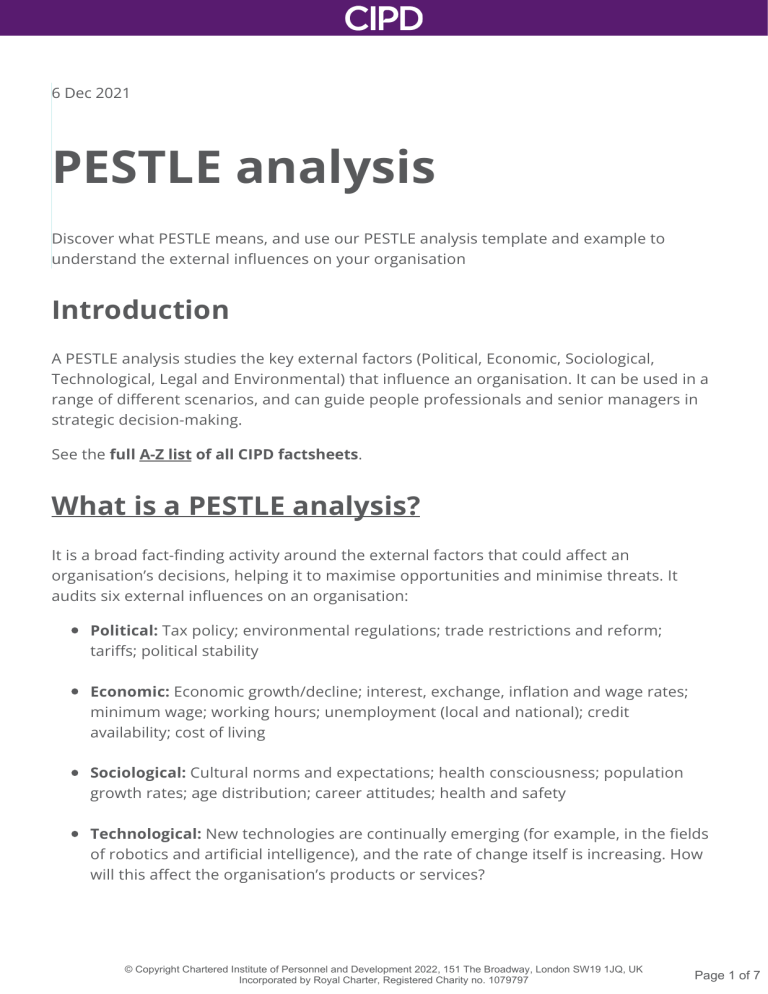
6 Dec 2021 PESTLE analysis Discover what PESTLE means, and use our PESTLE analysis template and example to understand the external influences on your organisation Introduction A PESTLE analysis studies the key external factors (Political, Economic, Sociological, Technological, Legal and Environmental) that influence an organisation. It can be used in a range of different scenarios, and can guide people professionals and senior managers in strategic decision-making. See the full A-Z list of all CIPD factsheets. What is a PESTLE analysis? It is a broad fact-finding activity around the external factors that could affect an organisation’s decisions, helping it to maximise opportunities and minimise threats. It audits six external influences on an organisation: Political: Tax policy; environmental regulations; trade restrictions and reform; tariffs; political stability Economic: Economic growth/decline; interest, exchange, inflation and wage rates; minimum wage; working hours; unemployment (local and national); credit availability; cost of living Sociological: Cultural norms and expectations; health consciousness; population growth rates; age distribution; career attitudes; health and safety Technological: New technologies are continually emerging (for example, in the fields of robotics and artificial intelligence), and the rate of change itself is increasing. How will this affect the organisation’s products or services? © Copyright Chartered Institute of Personnel and Development 2022, 151 The Broadway, London SW19 1JQ, UK Incorporated by Royal Charter, Registered Charity no. 1079797 Page 1 of 7 Legal: Changes to legislation impacting employment, access to materials, quotas, resources, imports/exports, and taxation Environmental: Global warming and the increased need to switch to sustainable resources; ethical sourcing (both locally and nationally), including supply chain intelligence. Pandemics and other emergencies. By analysing those factors, organisations can assess any risks specific to their industry and organisation, and make informed decisions. It can also highlight the potential for additional costs, and prompt further research to be built into future plans. Video: what is a PESTLE analysis and how does it work? Play Video Please scroll to the bottom of the factsheet to view the transcript of this video. PESTLE analysis is part of the core knowledge on enabling change and the core behaviour commercial drive in the CIPD Profession Map. How to do a PESTLE analysis Follow these steps: Identify the scope of the research. It should cover present and possible future scenarios, and apply to the industry and areas of the world in which the business operates. Decide how the information will be collected and by whom. Identify more than one person to gather data to bring diverse evidence and perspectives. Identify appropriate sources of information. You may find areas of PESTLE are a bigger focus to your industry than others but exploring information for all of them will give you a bigger view of the external environment. Gather the information – you can use the template below. Analyse the findings. Mark each item in terms of importance in relation to potential risk to the organisation. Identify the business options to address the issues. Write a discussion document for all stakeholders. Disseminate and discuss the findings with stakeholders and decision makers. Decide what actions need to be taken, and trends to be monitored. © Copyright Chartered Institute of Personnel and Development 2022, 151 The Broadway, London SW19 1JQ, UK Incorporated by Royal Charter, Registered Charity no. 1079797 Page 2 of 7 To be effective, a PESTLE analysis needs to be done regularly. Doing so can help organisations to spot trends early, and provide a competitive advantage. You can download a PESTLE analysis template below which will help you record PESTLE information. We’ve also created an example based on a fictitious retail sector organisation which shows how PESTLE factors have been analysed and interpreted. Blank PESTLE template PDF – available to download here. Completed PESTLE example PDF – available to download here. PESTLE analysis tips Some useful tips for carrying out a PESTLE analysis: Collaborate - multiple perspectives can identify more risk. Use expertise and resources within the organisation. Use PESTLE analysis alongside other techniques, such as SWOT analysis, Porter's Five Forces, competitor analysis, or scenario planning. Incorporate a PESTLE analysis into an ongoing process for monitoring changes in the business environment. Avoid collecting vast amounts of detailed information without analysing and understanding your findings appropriately. Don’t jump to conclusions about the future based on the past or present. What is a PESTLE analysis used for? By auditing the external environment, a PESTLE analysis can detect and understand broad, long-term trends. This can support a range of business planning situations, such as: Strategic business planning A PESTLE analysis provides contextual information about the business direction, its brand positioning, growth targets, and risks (such as another pandemic) to productivity. It can help determine the validity of existing products and services and define new product development. Workforce planning © Copyright Chartered Institute of Personnel and Development 2022, 151 The Broadway, London SW19 1JQ, UK Incorporated by Royal Charter, Registered Charity no. 1079797 Page 3 of 7 A PESTLE analysis can help to identify disruptive changes to business models that may profoundly affect the future employment landscape. It can identify skills gaps, new job roles, job reductions or displacements. Marketing planning A PESTLE analysis provides the ‘climate’ element in the situation analysis phase of the marketing planning process. It can help prioritise business activities to accomplish specific marketing objectives within a set timeframe. Product development By monitoring external activity, a PESTLE analysis can help inform whether to enter or leave a route to market, determine if a product or service still fulfils a need in the marketplace, or when to launch a new product. Organisational change A PESTLE analysis helps understand the context for change, and is most effective when used in association with a SWOT analysis to understand opportunities and threats around labour changes, such as skills shortages or current workforce capabilities. People strategies, reports and projects A PESTLE analysis can be used as a framework to look outside the organisation to hypothesise what may happen in future and what should be further explored. It can ensure that some basic factors are not overlooked or ignored when aligning people strategies to the broader organisation strategy. Advantages and disadvantages of a PESTLE analysis Advantages: It’s a simple framework. It facilitates an understanding of the wider business environment. It encourages the development of external and strategic thinking. It can enable an organisation to anticipate future business threats and take action to avoid or minimise their impact. It can enable an organisation to spot business opportunities and exploit them fully. © Copyright Chartered Institute of Personnel and Development 2022, 151 The Broadway, London SW19 1JQ, UK Incorporated by Royal Charter, Registered Charity no. 1079797 Page 4 of 7 Disadvantages: Some PESTLE analysis users oversimplify the amount of data used for decisions – it’s easy to use insufficient data. The risk of capturing too much data may lead to ‘paralysis by analysis’. The data used may be based on assumptions that later prove to be unfounded. The pace of change makes it increasingly difficult to anticipate developments that may affect an organisation in the future. To be effective, the process needs to be repeated on a regular basis. Useful contacts and further reading Contacts PEST analysis (Mindtools) Books and reports MORRISON, M. (2013) Strategic business diagnostic tools: theory and practice. CreateSpace Independent Publishing. (Chapter 3: PESTLE). TURNER, S. (2002) Tools for success: a manager’s guide. London: McGraw Hill. Journal articles DOBBS, M.E. (2014) Guidelines for applying Porter's five forces framework: a set of industry analysis templates. Competitiveness Review. Vol 24, No 1, pp32-45. CIPD members can use our online journals to find articles from over 300 journal titles relevant to HR. Members and People Management subscribers can see articles on the People Management website. Video transcript A PESTLE analysis is a management framework and diagnostic tool. The outcome of the analysis will help you to understand factors external to your organisation which can impact upon strategy and influence business decisions. © Copyright Chartered Institute of Personnel and Development 2022, 151 The Broadway, London SW19 1JQ, UK Incorporated by Royal Charter, Registered Charity no. 1079797 Page 5 of 7 The PESTLE tool: PESTLE is an acronym for: P = Political E = Economic S = Social T = Technology L = Legal E = Environmental Let’s look at each of these factors more closely, POLITICAL: When looking at Political factors you will need to take into account your countries government policies and political stability. Other factors will include tax implications, industry regulations and global trade agreements and restrictions. ECONOMIC: Economic factors will include exchange rates, economic growth or decline, globalisation, inflation, interest rates and the cost of living, labour costs and consumer spending. SOCIAL: Social factors look at trends such as lifestyle factors, cultural norms and expectations such as career attitudes and work-life balance. It also concerns itself with consumer tastes and buying habits as well as population demographics. TECHNOLOGY: Technology has grown exponentially. How is your business responding to technological innovation in your products and services? Other technological advancements will impact on data storage, disruptive technologies such as smartphones, social networking, automation robotics and the increasing shift towards AI artificial intelligence? LEGAL: Shifts in the Legal landscape are constantly changing especially here in the UK. Employment labour law and employment tribunal decisions impact upon working practices continuously. It is also important to keep up to date with all changes in legislation and of course Health and safety regulations. ENVIRONMENTAL: Does your business have a direct impact on the environment? Political sanctions now govern carbon emissions and a move towards sustainable resources such as wind turbines and recycling. This area also covers CSR corporate social responsibility and ethical sourcing of goods and services which in turn has a direct impact on procurement and your businesses supply chain management. Next steps: Once you are clear on the main overarching factors included in a PESTLE analysis the next challenge is to relate this in real terms into the industry sector you work in. © Copyright Chartered Institute of Personnel and Development 2022, 151 The Broadway, London SW19 1JQ, UK Incorporated by Royal Charter, Registered Charity no. 1079797 Page 6 of 7 Good luck. © Copyright Chartered Institute of Personnel and Development 2022, 151 The Broadway, London SW19 1JQ, UK Incorporated by Royal Charter, Registered Charity no. 1079797 Page 7 of 7
